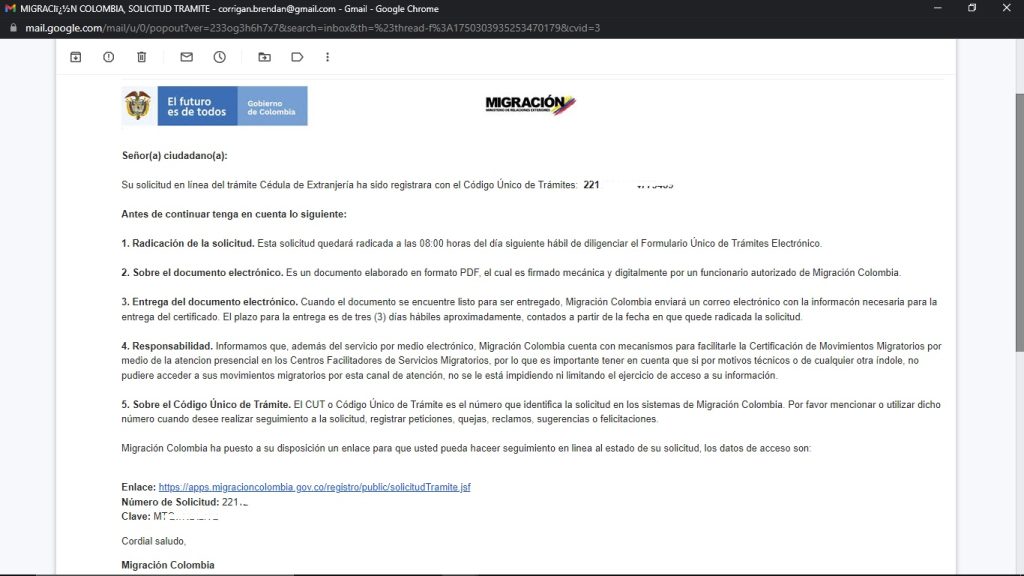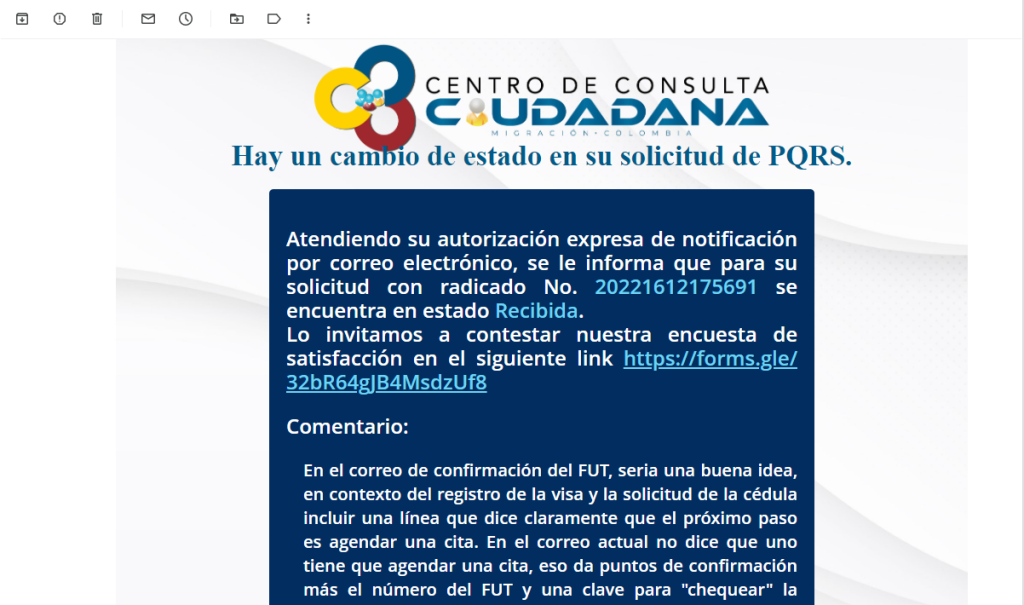Ingresa o regístrate acá para seguir este blog.
[Listen to an audio version of this blog entry here.]
Having more efficient, simpler processes is something the majority of us no doubt desire.

Migración Colombia’s Bogotá office: The employees are generally friendly and efficient, once you get into the building, that is.
In the ten years plus I’ve been using the services of Migración Colombia, its processes have become more streamlined. When online application systems work well, they certainly can be great timesavers. When they work well, that is.
Smooth operators
For the most part, in my experience, the online systems at both La Cancillería (for visa applications) and Migración Colombia (for registering visas and getting a cédula extranjería [foreign ID card]) are straightforward and largely hassle-free. (Meeting the actual requirements is another matter, and there have been numerous changes in this regard over the last couple of years.)
Lest I be accused of suffering from the ‘curse of knowledge’ following years of practice with these application processes, novice applicants might initially come undone with the maximum megabyte limit for the various PDF documents required. Making use of the website I Love PDF or the like is essential.
For the visa application with La Cancillería, making sure your photo meets the right specifications can be another snag. Again, however, there are plenty of online “fixes” for this.
I have heard of people having problems with uploading documents, even when they meet all the parameters, or being unable to pass a certain online stage because the system becomes stuck. These things have never happened to me, thankfully, but I have had unfathomable, enraging experiences on other websites.
Such inexplicable occurrences convert the digital utopia into a dystopia of sorts. Spending time in Orwell’s Room 101 would be more enjoyable than trying to make contact with an actual human being when facing an online conundrum.
Email omission
It wasn’t quite a technological problem, however, that had me rather miffed with Migración Colombia in my latest visa registration. It was more to do with a communications blind spot.
After being granted a two-year M visa as an independent worker — a small bit of palanca (preferential treatment) from La Cancillería may have helped me in this (I deserved a break, it was my turn!) — the next step was to register this at Migración, a prerequisite in order to get an updated Colombian ID reflecting my new status. One has 15 working days from the issuance of the visa to do this.
The initial registration is made, unsurprisingly, online via Migración’s Formula Único de Trámites (FUT), effectively a digital form for all procedures, you just select the appropriate one at the top of the page.
Once done successfully, a confirmation email is sent to the applicant containing the Código Único de Trámites (a registration number, basically) and a password to enter the system to “check” the progress of the application.
I emphasise the word check here because this is the case with the visa application, one which is fully online. With that, when you submit your documents and pay the study fee, it’s a case of playing the waiting game for La Cancillería to reply. You can easily check your application’s progress by entering the system; it tells you if it’s been reviewed or not.
‘I did try to explain to him that it would be quite helpful if this information was included in the confirmation email; my telepathy skills aren’t what they once were.’
Thus, this can frame the mind when dealing with Migración, especially so when in the confirmation email for the online registration no other useful information is given other than the registration number and password. That is, it doesn’t say that the applicant has to make the next move. (I showed the email to native Spanish speakers just in case I’d missed something, but no, I hadn’t.)
You see, I had been expecting an additional email saying that my online application was reviewed or something to that effect.
After a couple of weeks of hearing nothing, I started to get a little anxious, bearing in mind the 15-working-day time limit.
As luck, of sorts, has it, I happen to have the email for a relatively high-up employee at Migración Colombia. So I messaged her about my concerns. She told me that I had to go to the Bogotá Migración office in person to complete the process.
While that wasn’t/isn’t a major inconvenience in its own right, previous experience since the pandemic has taught me that just rolling up to Migración without a prior appointment is a no-no.
And so it was. I went there and in the queue outside — there’s always a queue outside — an official told me bluntly that I had to book an appointment online first.
I did try to explain to the man that it would be quite helpful if this information was included in the confirmation email; my telepathy skills aren’t what they once were. He was having none of it. It would appear he suffers from the curse of knowledge — in this regard only. It’s unlikely he’s knowledgeable in much else.
Overcoming the oversight
Back home after that rather tetchy encounter with the official, I went to Migración’s homepage. I couldn’t make out where exactly I was meant to make the appointment, I just kept on being brought to the FUT page.
So, I did a Google search for ‘agendar una cita Migración Colombia’ (‘book a Migración Colombia appointment’) and the appropriate page came up.
From there, booking was pretty easy. I got an appointment for the following morning. Do note, the confirmation email for this never arrived — and yes, I checked my spam folder. Luckily, I’d taken a screenshot of the appointment number. Had I failed to do so, I’m not sure how I would have got around that.
By my calculations, that morning I got into Migración to physically complete the registration was the 15th working day since my visa was issued, right on the deadline.
I informed the Migración official who registered my visa of this blind spot in their communications (she had asked why it had taken me so long to do it!).
To avoid unnecessary angst and potential heated exchanges with the Migración officials “guarding” the office entrance, all that’s required is a simple line in that confirmation email: ‘You now must book an appointment online via the following link in order to complete the process in person at a Migración office.’ Something like that.
The Migración woman told me, amicably, to put such an observation in writing for the suggestion box. I did.
And just to give it further airing, I’m putting it here.
It might be a small thing, but it can lead to a far smoother process with fewer misunderstandings. We could all do with that in our lives.
__________________________________________________________
Listen to Wrong Way’s Colombia Cast podcast here.
Facebook: Wrong Way Corrigan — The Blog & IQuiz “The Bogotá Pub Quiz”.



